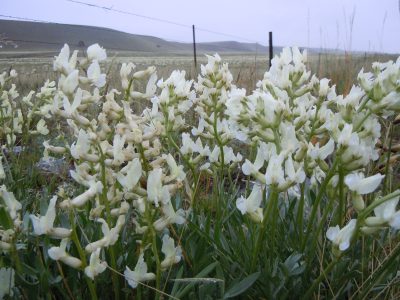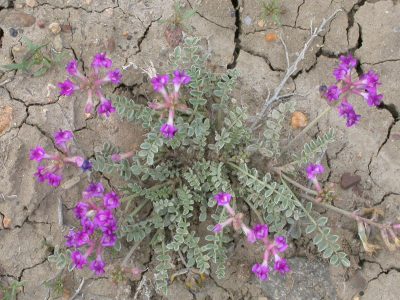The roadside ditches are filled with wildflowers this time of year and the colorful blooms feel like a reward for enduring another Wyoming winter. Don’t let the cheery blooms fool you, though; some of these flowering plants are toxic to livestock.
Identifying the culprit
The creamy flowers of white locoweed (Oxytropis sericea) are relatively subtle and easily overlooked, while the purple blooms of Lambert’s locoweed might easily be mistaken for lupine. Unfortunately, both of these toxic locoweed species are prevalent on rangelands throughout Wyoming.

The term locoweed refers to plants in the genera Oxytropis or Astragalus and is a nod to the toxic effects that cause livestock to go “loco,” or crazy. Oxytropis species can be identified by their pinnate (feather-like) leaves growing from a single crown and white or purple flowers arising on leafless stalks. Astragalus species locoweeds have similar flowers and leaves, but they occur on the same stem.
A close examination of a locoweed flower will reveal a petal layout with a single petal on the top (the banner petal), two petals on the sides, and a single petal on the bottom (the keel petal). If it is an Oxytropis species, the keel petal will be pointed; if it is an Astragalus species, the keel petal will be blunt.
Locoweed tends to green up earlier than other range plants in the spring and is appealing to grazing livestock when other forage is in short supply, making late spring and early summer a high-risk period. Locoweed populations increase in years with above normal precipitation and decrease in dry years.
The mechanism and consequences of toxicity
Locoweeds are also known as poison vetches because of their toxicity to mammals. Infection of the locoweed plant by a particular fungus causes swainsonine, a toxic alkaloid compound, to build up in leaves, stems and flowers. When consumed by grazing livestock over a sustained period, this alkaloid induces “locoism” by interfering with critical enzyme activity.

Some locoweed species are more toxic than others, and the concentration of the alkaloids varies from plant to plant. To learn more about alkaloid toxins, visit https://bit.ly/UWE-alkaloids to view the “Taming Toxic Plants” video series produced by Derek Scasta, University of Wyoming Extension range specialist.
Livestock experiencing alkaloid toxicosis from consuming locoweed show signs of distress after 10-12 days. Animals go off feed and exhibit signs of central nervous system dysfunction (rapid change in temperament, depression, head pressing, circling, and clumsy movements) after ingesting locoweed. These signs may be accompanied by a sudden decrease in body condition, a dull hair coat, and glassy eyes. Studies suggest that horses are more sensitive to locoweed alkaloid toxins than cattle and sheep.
Subclinical toxicity interferes with digestive and reproductive function. This manifests as reduced feed conversion rates, reduced conception rates, and diminished male fertility. Since locoweed actively grows during the summer breeding season, these effects are especially insidious for cow-calf producers; backgrounding operations may see decreased gains in years when locoweed populations are high. Dried locoweed leaves and stems retain their toxicity outside the active growing season, so if gestating females ingest locoweed on winter ranges, abortions may result.
Managing for locoweed
Unfortunately, there is no treatment available for locoism. The best practice is to remove livestock to a locoweed-free pasture or to feed locoweed-free hay. Some animals recover better than others, but neurological effects can linger for the remainder of the affected animal’s life.
Unlike other toxic plants, locoweed is quite palatable, and animals will return to graze it despite the detrimental effects to their health. This fact contributes to the lore of the locoism induced by these plants. Horses can become habituated, meaning they will intentionally graze locoweed despite the presence of non-toxic forage options. Cattle and sheep will also learn from each other and become socialized to eat locoweed.
Since treatment options are limited, the best solution is to cull animals that intentionally graze locoweed to prevent them from teaching this behavior to the rest of the herd.
Although they are native plants, locoweed species can be a nuisance for livestock producers. If elimination of locoweed on a property is desired, managers should follow the principles of integrated pest management (IPM) and utilize as many non-chemical control mechanisms as possible. Indiscriminate spraying of broadleaf herbicides will eliminate many beneficial plants and is not recommended unless necessary.
For more information on locoweed, check out the peer-reviewed article “Locoweed Toxicity, Ecology, Control, and Management” by Michael H. Ralphs and Bryan L. Stegelmeier of the USDA-ARS Poisonous Plant Research Laboratory at https://bit.ly/ARS-loco.
Land managers concerned about locoweed on their rangelands should contact their local Wyoming Weed and Pest District office or University of Wyoming Extension office for guidance.
Micah Most is the University of Wyoming Extension agriculture and natural resources educator serving Johnson County. He can be reached at mmost@uwyo.edu or (307) 684-7522.




